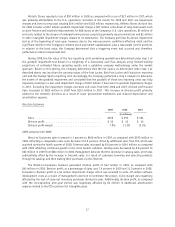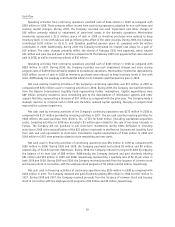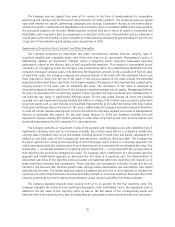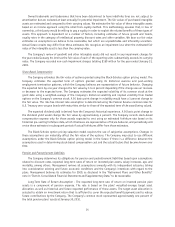Foot Locker 2009 Annual Report Download - page 42
Download and view the complete annual report
Please find page 42 of the 2009 Foot Locker annual report below. You can navigate through the pages in the report by either clicking on the pages listed below, or by using the keyword search tool below to find specific information within the annual report.
Owned trademarks and tradenames that have been determined to have indefinite lives are not subject to
amortization but are reviewed at least annually for potential impairment. The fair values of purchased intangible
assets are estimated and compared to their carrying values. We estimate the fair value of these intangible assets
based on an income approach using the relief-from-royalty method. This methodology assumes that, in lieu of
ownership, a third party would be willing to pay a royalty in order to exploit the related benefits of these types of
assets. This approach is dependent on a number of factors, including estimates of future growth and trends,
royalty rates in the category of intellectual property, discount rates and other variables. We base our fair value
estimates on assumptions we believe to be reasonable, but which are unpredictable and inherently uncertain.
Actual future results may differ from those estimates. We recognize an impairment loss when the estimated fair
value of the intangible asset is less than the carrying value.
The Company’s review of goodwill and other intangible assets did not result in any impairment charges for
the year ended January 30, 2010 as the fair value of each of the reporting units substantially exceeds its carrying
value. The Company recorded non-cash impairment charges totaling $169 million for the year ended January 31,
2009.
Share-Based Compensation
The Company estimates the fair value of options granted using the Black-Scholes option pricing model. The
Company estimates the expected term of options granted using its historical exercise and post-vesting
employment termination patterns, which the Company believes are representative of future behavior. Changing
the expected term by one year changes the fair value by 3 to 6 percent depending if the change was an increase
or decrease to the expected term. The Company estimates the expected volatility of its common stock at the
grant date using a weighted-average of the Company’s historical volatility and implied volatility from traded
options on the Company’s common stock. A 50 basis point change in volatility would have a 1 percent change to
the fair value. The risk-free interest rate assumption is determined using the Federal Reserve nominal rates for
U.S. Treasury zero-coupon bonds with maturities similar to those of the expected term of the award being valued.
The expected dividend yield is derived from the Company’s historical experience. A 50 basis point change to
the dividend yield would change the fair value by approximately 4 percent. The Company records stock-based
compensation expense only for those awards expected to vest using an estimated forfeiture rate based on its
historical pre-vesting forfeiture data, which it believes are representative of future behavior, and periodically will
revise those estimates in subsequent periods if actual forfeitures differ from those estimates.
The Black-Scholes option pricing valuation model requires the use of subjective assumptions. Changes in
these assumptions can materially affect the fair value of the options. The Company may elect to use different
assumptions under the Black-Scholes option pricing model in the future if there is a difference between the
assumptions used in determining stock-based compensation cost and the actual factors that become known over
time.
Pension and Postretirement Liabilities
The Company determines its obligations for pension and postretirement liabilities based upon assumptions
related to discount rates, expected long-term rates of return on invested plan assets, salary increases, age, and
mortality, among others. Management reviews all assumptions annually with its independent actuaries, taking
into consideration existing and future economic conditions and the Company’s intentions with regard to the
plans. Management believes its estimates for 2009, as disclosed in the ‘‘Retirement Plans and Other Benefits’’
note in ‘‘Item 8. Consolidated Financial Statements and Supplementary Data,’’ to be reasonable.
Long-Term Rate of Return Assumption - The expected long-term rate of return on invested pension plan
assets is a component of pension expense. The rate is based on the plans’ weighted-average target asset
allocation, as well as historical and future expected performance of those assets. The target asset allocation is
selected to obtain an investment return that is sufficient to cover the expected benefit payments and to reduce
future contributions by the Company. The Company’s common stock represented approximately one percent of
the total pension plans’ assets at January 30, 2010.
24
























